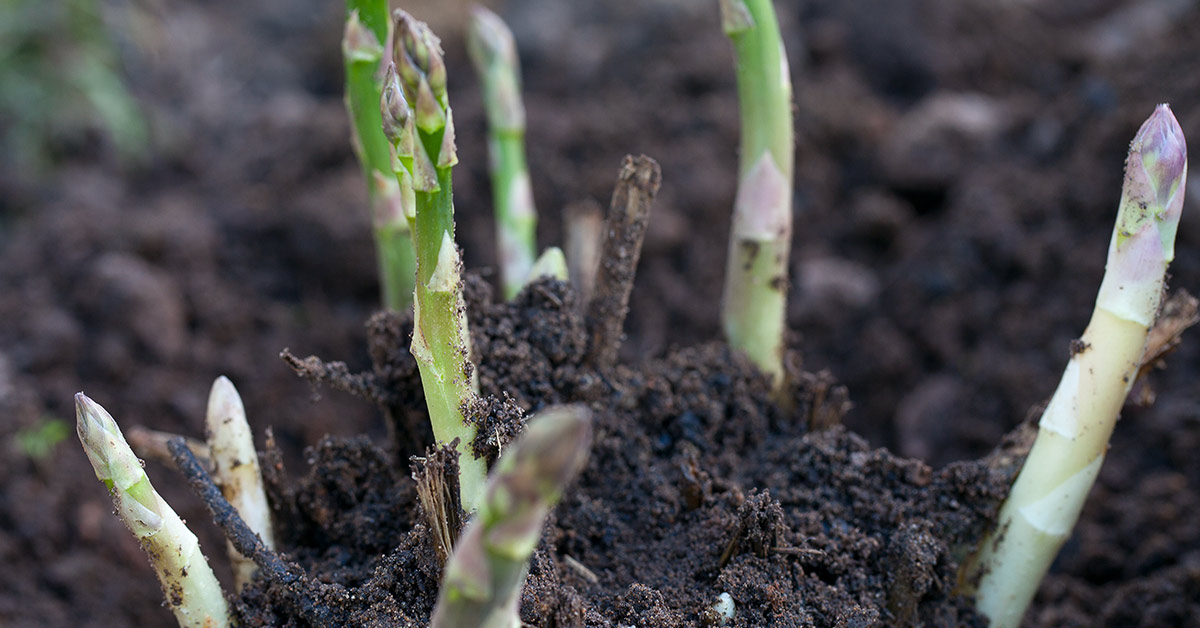Picture this: a dozen or so asparagus stalks harvested from your garden, soaked in melted butter, topped with pepper, finely minced garlic, and a little bit of salt. Tossed over a charcoal grill and grilled until just perfectly cooked. You bite into it and it’s so juicy, you can taste that butter and garlic so clearly with a hint of salt and pepper. That, folks, is what summertime tastes like to me. If you want that to be your reality too, you should learn how to grow asparagus right at home. It’s super simple and so rewarding.
Asparagus is one of my favorite plants to grow because it continuously grows back year after year, with some plants surviving perennially for up to three decades! Plus if you allow some of the stalks to grow to maturity, it’ll self seed and continue putting up more and more fresh asparagus stalks for you every year.
How to grow asparagus
Before we can start planting asparagus seeds or crowns, we need to talk climate. Is yours suitable for asparagus? If you live in Western Europe or North America, the answer is: probably. Asparagus is actually native to Western Europe but grows well throughout the United States in hardiness zones 2 through 8.
That said, asparagus enjoys climates where the ground freezes and there are periodical dry spells with very little precipitation. This means that much of the gulf coast of the US and areas further south are not suitable for asparagus. In Oregon, where I currently reside, you’d think it would be too damp but we have nice, hot, dry summers and very close to freezing winters. Asparagus does fine here.
Growing from seed
If you’re ready to grow some asparagus, there are two ways to do it. The first is from seed. Keep in mind that if you grow asparagus from seed, you’ll be waiting a few years before it really produces delicious asparagus stalks for you.
Once you’ve acquired some seeds, you will want to get them started indoors as early as February. The seeds will need bright light and warm soil between 70 and 85 degrees Fahrenheit. Soaking the seeds for 3 to 6 hours before planting helps with the germination process but isn’t required.
Fill small seed-starting pots with fertile soil specifically for vegetable seeds. Take 3 to 5 asparagus seeds and place them on the surface of the soil. Don’t bury them in a hole! Once placed, add a very thin later of sifted sand over them.
When watering, don’t water from the top. Instead, place your seed pods in a tray and water the tray. The water will seep up to the surface of the soil, watering your seeds as they germinate. Keep the pots damp but not drenched. Don’t let them dry out.
As mentioned, asparagus likes warm soil. It is advisable that you keep them in a fairly warm room as they germinate. They should be given three months indoors to get established before planting outside. Plant outdoors after the final risk of frost has passed.
Your asparagus plants should be planted 18 inches apart. If planting in rows, keep the rows 4 inches apart from one another. How you plant them will regulate how thick the spears are. If you want thinner spears, plant them four inches deep. If you want thicker spears, go for 6 to 8 inches deep.
Don’t harvest any of your asparagus for the first three years. It’s a long wait but well worth it.
Growing from crown
Growing asparagus from seed is the slow way. There is a much quicker way: growing from crowns. You can shop for asparagus crowns online. Generally it’s a good call to purchase them in late winter.
Asparagus crowns can be planted outdoors during springtime pretty much as soon as the soil can be worked, as they are more established and hardier than seedlings. Typically, asparagus crowns are about two years old, meaning that you should allow them to grow undisturbed for at least one growing season before harvesting. You may want to make a judgement call in the second year and allow them to grow normally without harvesting again.
Asparagus grows well both in raised beds and in the ground, but it likes soil with a neutral pH and soil that drains pretty well. Work a bit of well broken down compost into the soil and plant your asparagus plants about 12 inches deep. Again, leave about 18 inches between each plant and 4 inches between rows. It helps to add a bit of natural fertilizer, like fish emulsion, to each plant.
Only add one inch of soil to your asparagus crowns. As they grow, slowly add more soil until the holes are all filled in and level with the rest of your garden.
Keep your soil most and weeds out of your garden. Again, it’s best to wait at least one year, preferably two, to begin harvesting.













